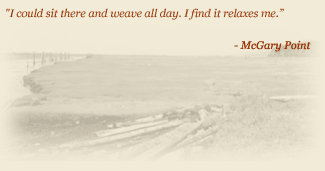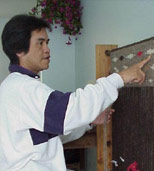

I have lived on the Musqueam Reserve most of my life. I enjoy living down here when it is peaceful. I have lived off and on reserve, but I always come back. Now I have my own home so I do not have to go anywhere.
I have been weaving and spinning since 1986. I started out knitting, and then I caught on to weaving and carried on. I knit slippers, sweaters, and toques. I wove a queen-sized blanket on a big giant loom and I am going to do another one. I hope to get a good price for it. That took me a year and a half to make in between all the little functions. I could sit there all day and weave, and that takes a lot of patience. I find that it relaxes me. When I get down, it will pick me up, and I just say, "Carry on." It's the only thing you can do.
When Wendy John started her first class, they tried to get me involved, and I just kind of said, "I'll just wait for the next class." During the following class, I would just go up and sit with them and have coffee, look at their work, and their different types of spinning. Every person had his or her own texture, which was something to see. Wendy asked if I'd like to try to spin so I said, "Why not give it a whirl?" So, I sat down, took some wool, and prepared it for spinning. I just got on that spinner and away I went. I had no complications at all. I must be a natural! From there I kept on. I bought my own wool and spun it. Then I just watched them weave, and from there I started on my own. For little things like the hooking and tabby, I asked Debra Sparrow for a little help, and my sister-in-law Margaret Louis. We all lived together, so she helped me out quite a bit with my weaving. My first challenge was at a big weaving. I said to myself, "Why not do the whole thing, and just let's see how it works."
I want to [start dyeing] my own wool. I also learned that from Wendy and the other weavers. We tried natural colors. I like the natural colors, because they're soft.
I do not have any graphed patterns. Designs just come to me, and I remember them. It is a challenge. If I like it, I'll finish it. If I don't, I'll take it down and start something else. I remember when my sister and I planned to thank some friends for what they did for her. We put up a big dinner and we presented a weaving to them for what they had done for us. We made them cover their eyes, and then we just placed it on their lap. I told my sister, "You watch, they're both going to cry." Sure enough, we thanked them and they just cried. I said, "Don't get any tears on it, it'll shrink!" I was happy with it. I just feel if I want to give it away, I'll just give it away. Just to make myself feel good that somebody else can have something from me. Knowing that they know, that I know how to weave.
Musqueam weaving is important because it's getting back the culture from the ancestors. It's interesting to see it come back to everybody. I'm proud of what I do. I'm proud that I can do all this.
› View McGary Point's Image Gallery




